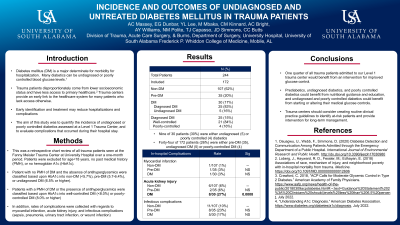Trauma
Category: Quickshot Oral Session 22
Quickshot Oral : Quickshot Oral Session 22
INCIDENCE AND OUTCOMES OF UNDIAGNOSED AND UNTREATED DIABETES MELLITUS IN TRAUMA PATIENTS
Tuesday, February 14, 2023
7:00am - 8:00am East Coast USA Time


Caroline Massey, BS
Medical Student
Frederick P. Whiddon College of Medicine, United States- CB
Charles Butts, MD
United States
Presenter(s)
Principal Contact(s)
Objectives: Diabetes is major determinate for mortality. Many diabetics are undiagnosed or poorly controlled. Trauma patients disproportionately come from lower socioeconomic status, which conveys a higher likelihood for adverse social determinants of health. Trauma centers have been able to provide an early link to the healthcare system for many patients that might not experience it otherwise. The aim of this study was to quantify the incidence of undiagnosed or poorly controlled diabetics assessed at a Level 1 Trauma Center, and to record any complications that occurred during their hospital stay.
Methods: This study was a retrospective chart review of all trauma patients seen at the Fanny Meisler Trauma Center at USA Health University Hospital over a one month period. On admission, a full medical history was taken, as well as an admission medication reconciliation were performed. Hemoglobin A1c (HbA1c) laboratory analysis was also done on admission for all patients assessed by the trauma service as part of our routine assessment labs. Patients were excluded if they were < 18 years old, did not have a HbA1c laboratory analysis, or did not have a past medical history (PMH). Undiagnosed diabetics were defined as patients with no PMH of diabetes and no antihyperglycemics on their admission medication reconciliation with an HbA1c ≥6.5%. Poorly controlled diabetics were defined as patients with a PMH of diabetes and/or antihyperglycemics on their admission medication reconciliation with a HbA1c >8.0%. In addition, pre-diabetics were defined as patients with no PMH of diabetes and no antihyperglycemics on their admission medication reconciliation with an HbA1c 5.7-6.4%.
Results: Chart review identified 244 patients. Seventy-one patients were excluded, leaving 173 for analysis. In total, 30 patients had an HbA1c ≥6.5%. Nine patients (30% of all diabetics) were undiagnosed or poorly controlled diabetics that may benefit from new or modified medical therapy. Further, an additional 35 patients (20% of the cohort) were undiagnosed pre-diabetics that may benefit from early interventions, including lifestyle modification and education. Overall, 25% of all patients would benefit from an intervention for improved glucose control.
Conclusion: Our data shows that 25% of all trauma patients admitted to our Level 1 trauma center would benefit from an intervention for improved glucose control. Trauma centers should consider creating routine clinical practice guidelines to identify at-risk patients and provide intervention for long-term management.
Methods: This study was a retrospective chart review of all trauma patients seen at the Fanny Meisler Trauma Center at USA Health University Hospital over a one month period. On admission, a full medical history was taken, as well as an admission medication reconciliation were performed. Hemoglobin A1c (HbA1c) laboratory analysis was also done on admission for all patients assessed by the trauma service as part of our routine assessment labs. Patients were excluded if they were < 18 years old, did not have a HbA1c laboratory analysis, or did not have a past medical history (PMH). Undiagnosed diabetics were defined as patients with no PMH of diabetes and no antihyperglycemics on their admission medication reconciliation with an HbA1c ≥6.5%. Poorly controlled diabetics were defined as patients with a PMH of diabetes and/or antihyperglycemics on their admission medication reconciliation with a HbA1c >8.0%. In addition, pre-diabetics were defined as patients with no PMH of diabetes and no antihyperglycemics on their admission medication reconciliation with an HbA1c 5.7-6.4%.
Results: Chart review identified 244 patients. Seventy-one patients were excluded, leaving 173 for analysis. In total, 30 patients had an HbA1c ≥6.5%. Nine patients (30% of all diabetics) were undiagnosed or poorly controlled diabetics that may benefit from new or modified medical therapy. Further, an additional 35 patients (20% of the cohort) were undiagnosed pre-diabetics that may benefit from early interventions, including lifestyle modification and education. Overall, 25% of all patients would benefit from an intervention for improved glucose control.
Conclusion: Our data shows that 25% of all trauma patients admitted to our Level 1 trauma center would benefit from an intervention for improved glucose control. Trauma centers should consider creating routine clinical practice guidelines to identify at-risk patients and provide intervention for long-term management.

